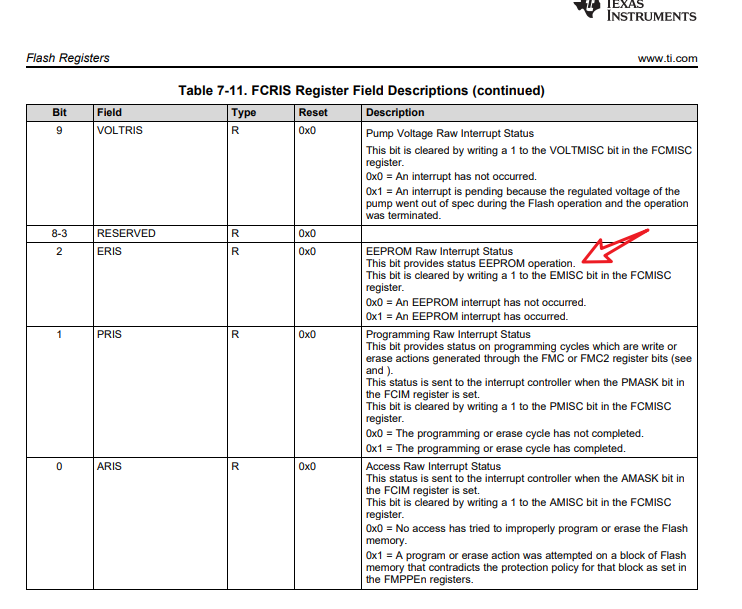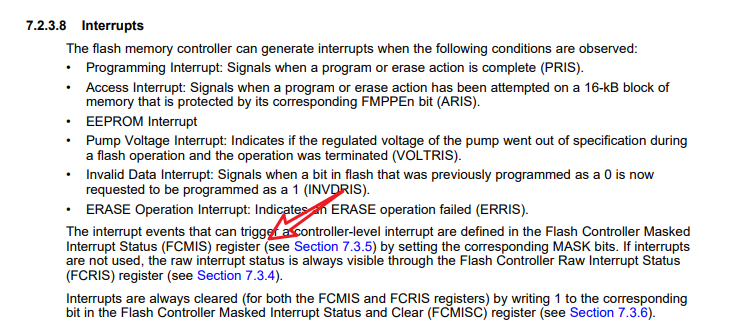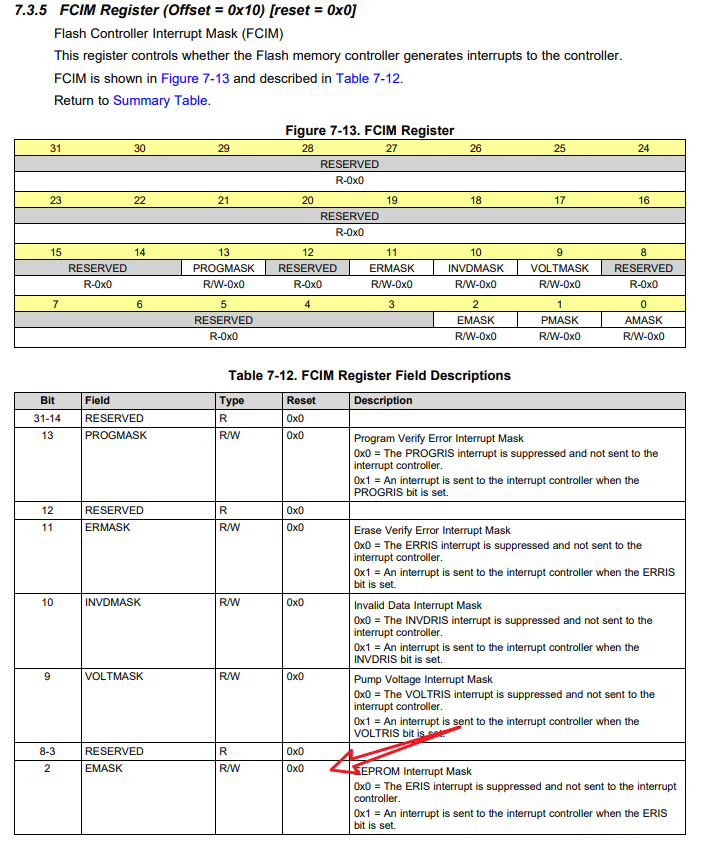Hello,
I have a question about Internal Memory of MSP432E401Y.
I want to get the data from EEOROM using EEPROMRead() provided by Eeprom_api.
I add EEPROM interrupt Survice Routine and setting interrupt to EEPROM sample project provided by TI.
( \ti\simplelink_msp432e4_sdk_3_10_00_11\examples\nortos\MSP_EXP432E401Y\driverlib\eeprom_erase_pgm_read )
When I call EEPROMRead(), This code enter the EEPROM Interruput Survice Routine.
In the TRM, it seems that an interrupt is generated when Write is completed or error has occured.
Dose An interrupt also generate during the Read process?
If an interrupt is generated Read process, is there a way to mask it?
The following is sample code adding ISR and Interrupt setting.
/* DriverLib Includes */
#include <ti/devices/msp432e4/driverlib/driverlib.h>
/* Standard Includes */
#include <stdint.h>
#include <stdbool.h>
/* Utils Includes */
#include "uartstdio.h"
/* Define for count */
#define EEPROM_WORDLIMIT 32
#define SYSTICK_CNTMS 10
/* Custom define for EEPROM Operation State*/
#define EEPROM_READREQ 0x0
#define EEPROM_ERASEREQ 0x1
/**/
volatile uint8_t getNextEEPROMOperation = 0;
volatile uint8_t setTickCount = 0;
void FLASH_IRQHandler(void)
{
uint32_t ui32InterruptStatus; // Interruput factor
uint32_t ui32E2pStatus; // EEPDONE
// Interrupt factor get
ui32InterruptStatus = MAP_FlashIntStatus(false);
// clear Interrupt factor
MAP_FlashIntClear(ui32InterruptStatus);
if ((ui32InterruptStatus & 0x04) == 0x04) {
ui32E2pStatus = MAP_EEPROMStatusGet();
}
else {
// Do Nothing
}
}
void SysTick_Handler(void)
{
setTickCount++;
}
void GPIOJ_IRQHandler(void)
{
uint32_t getSwitchState;
/* Read the interrupt status register to find which switch button was
* pressed and clear the interrupt status */
getSwitchState = MAP_GPIOIntStatus(GPIO_PORTJ_BASE, true);
MAP_GPIOIntClear(GPIO_PORTJ_BASE, getSwitchState);
/* If User Switch SW1 is pressed set the flag for erase request */
if(getSwitchState & GPIO_PIN_0)
{
HWREGBITB(&getNextEEPROMOperation, EEPROM_ERASEREQ) = 1;
}
/* If User Switch SW2 is pressed set the flag for read request */
if(getSwitchState & GPIO_PIN_1)
{
HWREGBITB(&getNextEEPROMOperation, EEPROM_READREQ) = 1;
}
}
void ConfigureUART(uint32_t systemClock)
{
/* Enable the clock to GPIO port A and UART 0 */
MAP_SysCtlPeripheralEnable(SYSCTL_PERIPH_GPIOA);
MAP_SysCtlPeripheralEnable(SYSCTL_PERIPH_UART0);
/* Configure the GPIO Port A for UART 0 */
MAP_GPIOPinConfigure(GPIO_PA0_U0RX);
MAP_GPIOPinConfigure(GPIO_PA1_U0TX);
MAP_GPIOPinTypeUART(GPIO_PORTA_BASE, GPIO_PIN_0 | GPIO_PIN_1);
/* Configure the UART for 115200 bps 8-N-1 format */
UARTStdioConfig(0, 115200, systemClock);
}
int main(void)
{
uint32_t systemClock;
uint32_t setCurrTime = 0;
uint8_t ii;
uint32_t retInitStatus;
uint32_t setDataforEEPROM[EEPROM_WORDLIMIT];
uint32_t getDatafromEEPROM[EEPROM_WORDLIMIT];
uint8_t count;
/* Configure the system clock for 120 MHz */
systemClock = MAP_SysCtlClockFreqSet((SYSCTL_XTAL_25MHZ | SYSCTL_OSC_MAIN |
SYSCTL_USE_PLL | SYSCTL_CFG_VCO_480),
120000000);
/* Configure the UART for display on the Terminal */
ConfigureUART(systemClock);
/* Enable the clock to the GPIO Port J and wait for it to be ready */
MAP_SysCtlPeripheralEnable(SYSCTL_PERIPH_GPIOJ);
while(!(SysCtlPeripheralReady(SYSCTL_PERIPH_GPIOJ)))
{
}
/* Configure the GPIO PJ0-PJ1 as input */
MAP_GPIOPinTypeGPIOInput(GPIO_PORTJ_BASE, (GPIO_PIN_0 | GPIO_PIN_1));
GPIOJ->PUR = GPIO_PIN_0 | GPIO_PIN_1;
/* Configure Interrupt Generation by Port Pin PJ0-PJ1 as falling edge */
MAP_GPIOIntTypeSet(GPIO_PORTJ_BASE, (GPIO_PIN_0 | GPIO_PIN_1),
GPIO_FALLING_EDGE);
MAP_GPIOIntEnable(GPIO_PORTJ_BASE, (GPIO_INT_PIN_0 | GPIO_INT_PIN_1));
MAP_IntEnable(INT_GPIOJ);
/* Enable the EEPROM Module and Initialize the EEPROM Block */
MAP_SysCtlPeripheralEnable(SYSCTL_PERIPH_EEPROM0);
while(!(SysCtlPeripheralReady(SYSCTL_PERIPH_EEPROM0)))
{
}
retInitStatus = MAP_EEPROMInit();
//-----EEPROM Interruput Setting-----//
MAP_EEPROMIntEnable(EEPROM_INT_PROGRAM);
MAP_IntEnable(INT_FLASH);
/* If EEPROM did not initialize then exit the program code */
if(retInitStatus != EEPROM_INIT_OK)
{
UARTprintf("Error Initializing EEPROM\n");
return 0;
}
UARTprintf("EEPROM Test Started\n");
UARTprintf("Press USR_SW1 for Mass Erase \n");
UARTprintf("Press USR_SW2 for Reading the current EEPROM Data\n");
/* Enable the SysTick timer to generate an interrupt every 1/10 second */
MAP_SysTickPeriodSet(systemClock/SYSTICK_CNTMS);
MAP_SysTickIntEnable();
MAP_SysTickEnable();
while(1)
{
/* Wait for 1 second and clear the variable to 0*/
while(setTickCount != SYSTICK_CNTMS)
{
}
setTickCount = 0;
setCurrTime++;
/* Check if a read request is pending */
#if 0
if(HWREGBITB(&getNextEEPROMOperation, EEPROM_READREQ) == 1)
{
/* read the EEPROM to an array and print it to the UART */
MAP_EEPROMRead(&getDatafromEEPROM[0], 0, EEPROM_WORDLIMIT*4);
UARTprintf("Read EEPROM Data...\n");
for(ii = 0; ii < EEPROM_WORDLIMIT; ii++)
{
UARTprintf("EEPROM Word %d = 0x%08x\n",ii ,getDatafromEEPROM[ii]);
}
/* Now clear the flag so that the loop is not re-entered */
HWREGBITB(&getNextEEPROMOperation, EEPROM_READREQ) = 0;
}
else if(HWREGBITB(&getNextEEPROMOperation, EEPROM_ERASEREQ) == 1)
{
UARTprintf("Running EEPROM Erase and then Read Data...\n");
/* Reset the Current Ticker Time */
setCurrTime = 0;
/* Erase the EEPROM */
retInitStatus = MAP_EEPROMMassErase();
if(retInitStatus != 0)
{
UARTprintf("ERROR Erasing EEPROM. EEPROM ERROR Code 0x%08x", retInitStatus);
break;
}
/* read the EEPROM to an array and print it to the UART */
MAP_EEPROMRead(&getDatafromEEPROM[0], 0, EEPROM_WORDLIMIT*4);
for(ii = 0; ii < EEPROM_WORDLIMIT; ii++)
{
UARTprintf("EEPROM Word %d = 0x%08x\n",ii ,getDatafromEEPROM[ii]);
}
/* Now clear the flag so that the loop is not re-entered */
HWREGBITB(&getNextEEPROMOperation, EEPROM_ERASEREQ) = 0;
count++;
}
else
{
/* The Current Ticker Time left shifted and OR-ed with the Word
* count is the unique value written to each location */
for(ii = 0; ii < EEPROM_WORDLIMIT; ii++)
{
setDataforEEPROM[ii] = (setCurrTime << 8 | ii);
}
/* Program EEPROM from Word 0 to 32 */
MAP_EEPROMProgram(&setDataforEEPROM[0], 0, EEPROM_WORDLIMIT*4);
}
#else
/* read the EEPROM to an array and print it to the UART */
MAP_EEPROMRead(&getDatafromEEPROM[0], 0, EEPROM_WORDLIMIT*4);
UARTprintf("Read EEPROM Data...\n");
for(ii = 0; ii < EEPROM_WORDLIMIT; ii++)
{
UARTprintf("EEPROM Word %d = 0x%08x\n",ii ,getDatafromEEPROM[ii]);
}
#endif
}
}
I look forward to your reply!
Regards,
Koki Tamai




